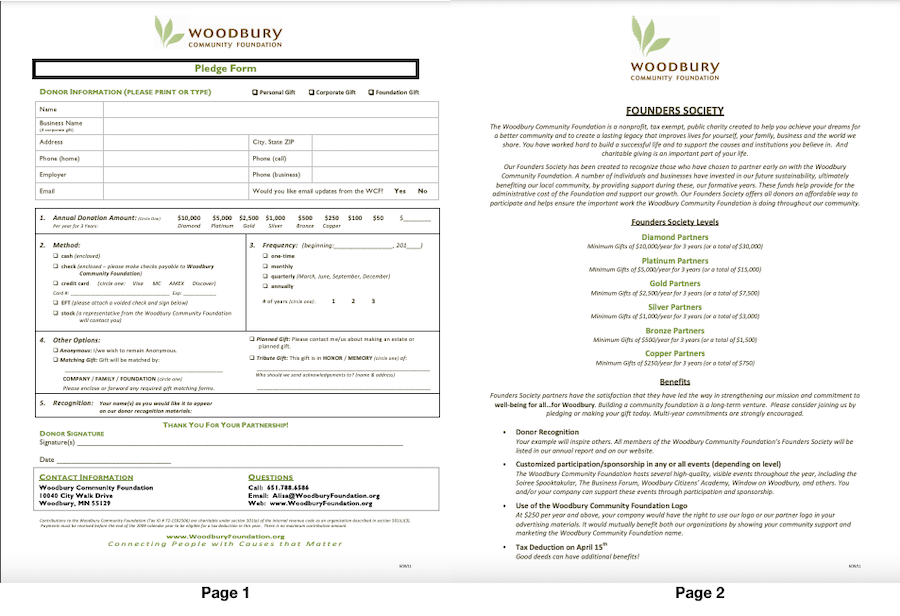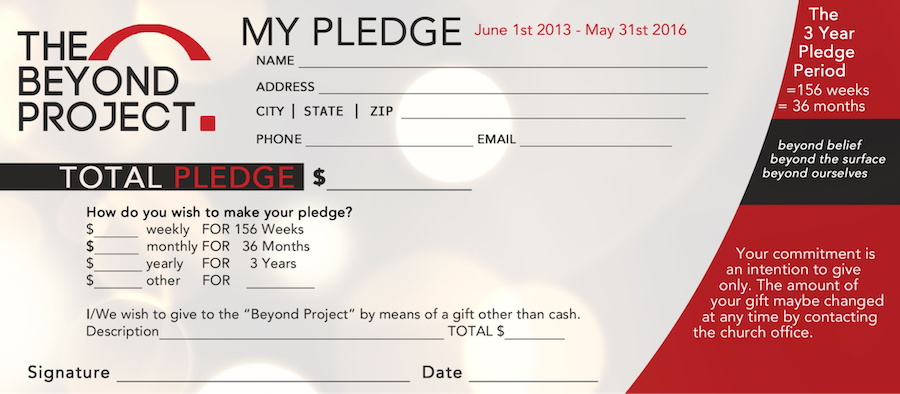Table of Contents
Pledging donations needs a mix of strategy and technology to successfully support organizations.
Today, ‘the best experience anywhere is the expected experience everywhere.’ Meaning we’re (nonprofits) all now held to the same benchmarks as Amazon, Starbucks, and other for-profit companies.
Emily Eakin, Traction on Demand Principal Strategist
One of these benchmarks is adopting digital technology more aggressively.
Why?
Because as time passes, tech-savvy millennials and Gen-Zs will take center stage as your supporters. And traditional ways of connecting with these target audience won’t be as effective.
One aspect of nonprofit fundraising that needs a substantial digital update is pledging donations.
In this post, we’ll examine pledges and donations along with the best way to shift from traditional methods (like using supporter’s pledge forms) to more novel methods.
Pledging donations: What is a donor pledge?
Donor commitments are simply promises made by donors to give an organization a certain amount of money on a future date or over a set amount of time.
Primarily, there are three methods of pledging donations:
- Conditional Pledge: This is when donors commit to donating a certain amount only when a condition is met. For example, city residents are pledging some of their earnings to a disaster relief organization for emergencies.
This is a conditional pledge, with the occurrence of a disaster/emergency being the condition.
- Unconditional Pledge: This is when a supporter commits to paying an amount later without any reservation. For example, a business may pledge 5% of its revenue to a nonprofit at the end of the fiscal year.
- Hybrid pledges: These pledges combine the above methods. A donor promises to give a charitable contributions at a future date and an additional amount only when a condition is met. For example, a major donor may pledge a monetary donation of $200,000 to their school sports teams, a football team for instance, at the end of the year and an additional $5,000 for every game the team wins.
Pledging donations: What is the difference between a pledge and a donation?
While both results are the same (you securing funds from your donors), the process is where significant differences lie.
Those differences are:
| Pledge | Donation | |
| Payment time frame | At a specific date in the future or over a period of time. Only a promise is made in response to the ask. | Immediate. A donation is made on the spot in response to the ask. |
| Payment conditions | There are no conditions for donating. | There are no conditions for making a donation. |
Pledging donations: How do you receive donor pledges (the traditional way)
Pledge nonprofit organizations fundraising are campaigns that collect pledges (instead of donations). Generally, most of these campaigns are in-person (like fundraising events) or campaigns where volunteers collect pledges door-to-door (e.g., for disaster relief).
Given the nature of these campaigns (and the fact these campaigns came into existence before a lot of the tech we have today), organizations relied on the following methods to collect pledges:
- Donor commitment forms
- Donor’s donation form
Let’s look at them in detail.
1. Donation pledge forms
These are pre-formatted forms used to record a donor’s pledge to a fundraiser.
Pledge formsof donors are typically distributed during events to reach out to new and existing donors and compel them to promise a donation. These forms are usually designed to be longer than cards (discussed below) to get detailed data on new supporters.
Apart from the fields for basic details (like donor name, address, pledge, etc.), these forms also often include:
- Text fields for preferred methods of giving.
- Recognition preferences (do they want to be anonymous or not).
- Other ways the donor can help (like matching gifts or corporate philanthropy).
- Fields for payment information and details.
- Information about the nonprofit or mission statement (typically at the back of the form).
Donor pledging form sample
Here’s a sample of pledge form from the Woodbury Community Foundation.

2. Donation forms for pledging nonprofit organizations
These cards are similar to donor pledge forms except for being more concise. Typically, these cards reach out to existing supporters during meets or through direct mail.
Since organizations will likely have most of the data they need on existing supporters, the cards don’t have to be very long. However, they do ask for the primary contact details to properly record the pledges against the right supporter.
Donor pledge card sample
Here’s a sample of a donor’s intended pledge card handed out by The Beyond Project.

While donor pledge forms and cards vary in the information they collect, there’s no hard and fast rule about their usage. You can still use forms for direct mail fundraising and event cards if you’d like.
Pledging donations: Challenges with traditional ways of collecting donor pledges
While they are widely used, the pen-and-paper model for pledging donations poses the following challenges:
- Increased expenses: You will have to spend a lot printing out several copies of donor pledge forms. Cards can be even more expensive, given that you have to print them out in color on card stock (a thicker form of paper).
- Excessive manual labor: You must assign volunteers to help with administrative tasks. These include getting the printouts, going door-to-door to distribute them, collecting them back, etc.
- Manual data entry: Once you get the pledges back, manually entering the data into your spreadsheets is another task you must struggle through. Apart from being arduous, the possibility of error when manually entering data is also a challenge.
- Complicated tracking: After the tedious manual data entry process, you’ll also need to manually keep track of people to follow up with and collect donations.
New ways of receiving pledging donations
To overcome the challenges of the traditional ways and to cater to the tech-savvy generations, you have to adopt new practices to receive donor pledges.
Here are two simple strategies that you can adopt.
1. Online donor pledge forms
Online donor pledge forms are just digital copies of your physical forms hosted on your nonprofit’s website. So instead of having to distribute physical copies, you can just share a link to the page and get people to pledge donations.
There are two primary ways to host online donor pledge forms:
- On a dedicated landing page: This landing page would be exclusive to your pledge fundraising campaign.
- As part of your donation page: On your donation page, you can also provide the option for pledging donations rather than donating immediately.
Fundraising tools like Funraise can help you collect pledges in both ways.
2. Text-to-pledge or Mobile Pledge
With over 85% of people owning and actively using a smartphone, it’s only obvious to leverage mobile phones to get people to pledge donations.
It’s easy, people are comfortable with the technology, and since everyone has their phone at hand most of the time, it’s quick too.
Similar to text fundraising, there are two ways donors can go about pledging donations over mobile:
- Text-to-pledge: Donors simply text an amount, their name, and other details in a specific format (based on the requirements of the carrier solution). This data is fed into your CRM, wherein you can set up reminders to follow up and collect donations.
- Mobile pledge: Donors can text in a keyword to receive your online pledge form link. They open it with one click and fill it out. The data is imported to your CRM, wherein you can segment your lists, set up reminders, and follow-ups with donors.
To implement text-to-pledge, you’ll have to sign-up for a service like Give By Cell that offers this solution. Mobile pledging can be carried out using a comprehensive SMS marketing tool.
Benefits of collecting pledges in the new ways
There’s no doubt that the digital methods of pledging donations help overcome the challenges of the traditional ways quite easily.
- Data entry eliminated: Since digital tools seamlessly integrate with CRMs, the transfer of data is automatic. So the need to enter data manually by reading them off a piece of paper is eliminated.
- Better user experience: With online methods, donors now don’t have to find a pen, fill out all details, and hand over the form (or mail it back). They can simply pledge donations with a few clicks and taps, which ensures a much better experience.
- Automated tasks: An added benefit of the digital approach for pledging donations is that routine tasks like sending out reminders for pledge deadlines, collecting donations, and sending thank you or confirmation messages can be easily automated.
These benefits prove that a digital-first approach for charitable giving – leveraging websites, automation, and social media – will be much more cost and resource-efficient for your organization.
Moving forward
Hopefully, the overview of pledge fundraising campaigns has equipped you with enough knowledge to adopt online or mobile donor pledge forms for pledging donations.
But, just like any nonprofit fundraising technique, there’s always room to improve a strategy with a few best practices. So before setting up your pledge fundraisers, check out these Pledge Fundraising Tips to help you make the most of your efforts.
Featured image source: Photo by Womanizer WOW Tech on Unsplash

